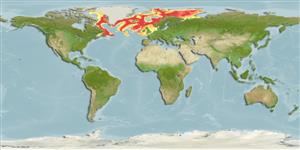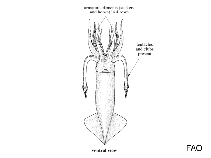Gonatus fabricii (Lichtenstein, 1818)
Boreoatlantic gonate squid| Native range | All suitable habitat | Point map | Year 2050 |

|
| This map was computer-generated and has not yet been reviewed. |
| Gonatus fabricii AquaMaps Data sources: GBIF OBIS |
Upload your photos
Google image | No image available for this species;
drawing shows typical species in Gonatidae.
Google image | No image available for this species;
drawing shows typical species in Gonatidae.
Classification / Names Common names | Synonyms | CoL | ITIS | WoRMS
| Oegopsida | Gonatidae
Environment: milieu / climate zone / depth range / distribution range Ekologi
Pelagiska; djupintervall 0 - 2700 m (Ref. 275). Tropical; 82°N - 47°N, 73°W - 63°E (Ref. 275)
Utbredning Länder | FAO områden | Ekosystem | Förekomster | Utplanteringar
Offshore arctic and subarctic waters of northern Atlantic from Newfoundland Basin, around Greenland and eastward to the Barents Sea. Tropical to polar.
Length at first maturity / Size / Vikt / Age
Maturity: Lm ? range ? - ? cm Max length : 38.5 cm ML hane/ej könsbestämd; (Ref. 85090); rapporterad maxålder: 3.00 år (Ref. 120434)
Maximum depth from Ref. 85090. Juveniles feed on copepods, euphausiids, amphipods, pteropods and chaetognaths (Ref. 275).
Life cycle and mating behavior Könsmognad | Reproduktion | Lek | Ägg | Fecundity | Larver
Members of the class Cephalopoda are gonochoric. Male and female adults usually die shortly after spawning and brooding, respectively. Mating behavior: Males perform various displays to attract potential females for copulation. During copulation, male grasp the female and inserts the hectocotylus into the female's mantle cavity where fertilization usually occurs. Life cycle: Embryos hatch into planktonic stage and live for some time before they grow larger and take up a benthic existence as adults.
Main reference
referenser | Koordinator | Medarbetare
Roper, C.F.E., M.J. Sweeney and C.E. Nauen. 1984. (Ref. 275)
IUCN Red List Status (Ref. 130435)
Least Concern (LC) ; Date assessed: 03 May 2010
CITES status (Ref. 108899)
Not Evaluated
CMS (Ref. 116361)
Not Evaluated
Threat to humans
Human uses
Fiskeri: av potentiellt intresse; bete: occasionally
| FishSource |
Verktyg
Ytterligare information
Internet-källor
BHL | BOLD Systems | CISTI | DiscoverLife | FAO(Publication : search) | Fishipedia | GenBank (genome, nucleotide) | GloBI | Gomexsi | Google Books | Google Scholar | Google | PubMed | Tree of Life | Wikipedia (Go, sök) | Zoological Record
Estimates based on models
Preferred temperature
(Ref. 115969): 0.8 - 9.1, mean 3.9 (based on 544 cells).



